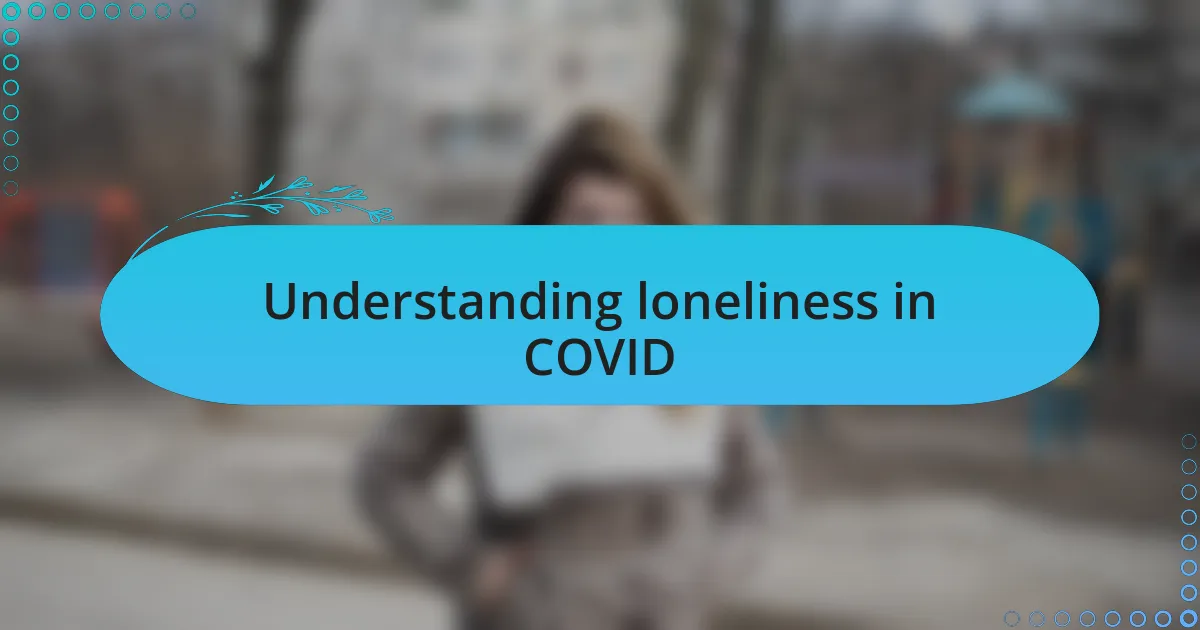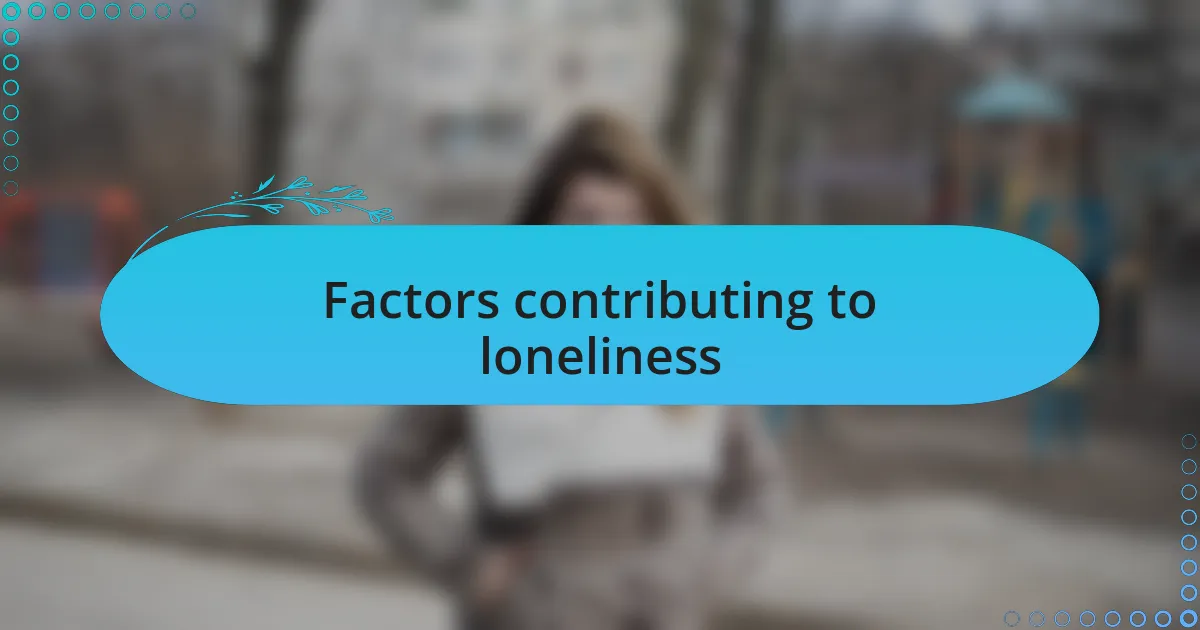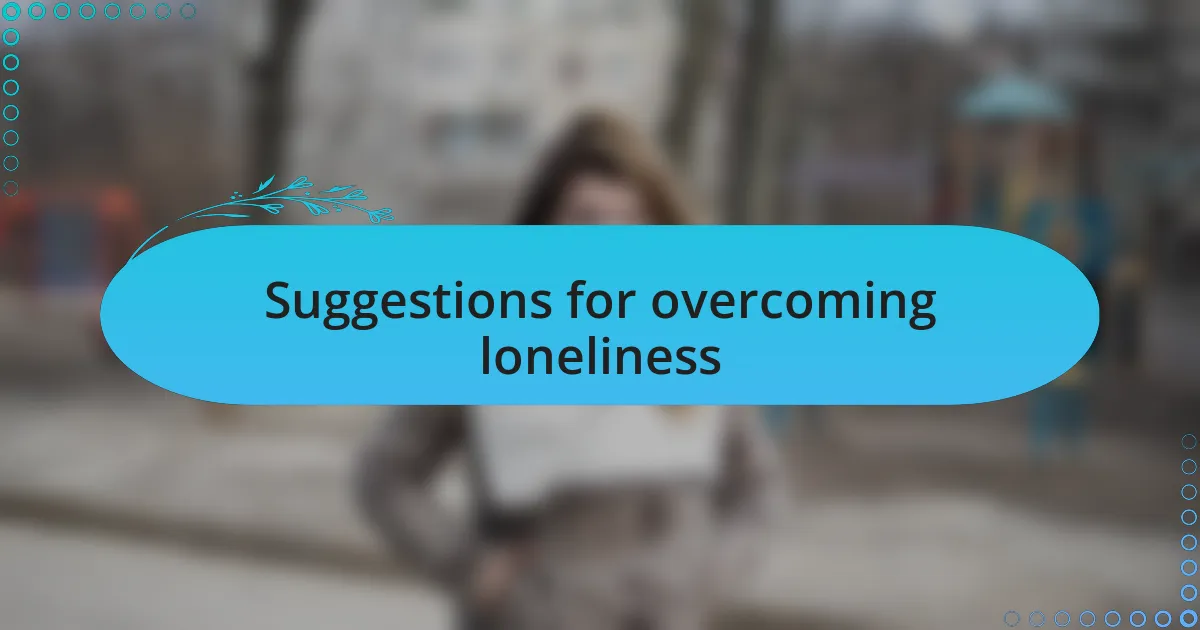Key takeaways:
- Loneliness during COVID was often exacerbated by the lack of social interactions and the abrupt shift to remote work, leading to increased anxiety and depression.
- Establishing routines and connecting with friends through digital means helped individuals cope with feelings of isolation.
- Personal reflections highlighted the transformational power of nature, journaling, and creativity in overcoming loneliness.
- Engaging with online communities and reaching out to others can foster feelings of connection and diminish loneliness.

Understanding loneliness in COVID
Navigating through the waves of confinement during COVID, I often felt like a ghost in my own home. Days blurred into weeks, and the silence was deafening. It makes me wonder, how many of us truly understood the depth of our loneliness only when faced with such isolation?
I recall a moment when a dear friend reached out after weeks of silence, sharing how even mundane tasks felt heavy without the buzz of companionship. In that instant, I realized that loneliness isn’t merely the absence of company; it manifests in our thoughts, amplifying every worry and doubt. It raises the question: can we learn to embrace solitude as a space for self-discovery, rather than simply a void?
Many people instinctively turned to technology for connection, yet I often wondered if that was enough. Virtual hangouts and social media could bridge the gap, but they lacked the warmth of a genuine hug or a shared laughter. Reflecting on my experiences, I’ve come to understand that while technology can connect us, it can’t always mend our hearts.

Research findings on loneliness
Research suggests that loneliness during the COVID pandemic led to heightened feelings of anxiety and depression for many individuals. In my experiences, I noticed how the simple act of not hearing a friend’s laughter left a tangible void. It made me question: could we genuinely recognize the psychological toll of solitude without these connections?
One study highlighted that social distancing measures resulted in a significant increase in reports of loneliness, particularly among young adults. I remember speaking to a colleague who shared how their daily routine felt incomplete without the spontaneous coffee breaks that once fostered camaraderie. It made me reflect on how our social environments shape our emotional states.
Moreover, findings indicate that loneliness can have lasting effects on physical health, linking it to issues like heart disease and weakened immune response. This connection deeply resonated with me, as I often thought about how intertwined our mental well-being is with our physical health. It raises an important question: what can we, as a community, do to cultivate connections that endure beyond times of crisis?

Factors contributing to loneliness
One significant factor contributing to loneliness during COVID-19 was the abrupt halt of social activities. I vividly recall a friend’s wedding that had to be postponed. This event represented more than just a celebration; it was a gathering that brought people together. The absence of shared experiences, like that wedding, created a void in many lives, making me wonder: how do we fill the gaps left by missed milestones?
Another contributing factor was the shift to remote work and learning. While I enjoyed the flexibility of working from home, I often felt isolated from my colleagues. The virtual meetings lacked the warmth of face-to-face interactions, leaving me yearning for the casual conversations that flow effortlessly in an office. I think about how vital those small interactions were in building relationships, which raises the question: can we truly replace in-person connections with screens?
Finally, the pervasive fear and uncertainty surrounding the pandemic heightened feelings of loneliness for so many. I remember watching the news and feeling an overwhelming sense of helplessness. Each headline seemed to echo a shared anxiety, yet ironically, it isolated us further. It makes me reflect on how the global sentiment of fear can create a personal disconnection: are we all yearning for connection in an age where fear separates us?

Coping strategies during isolation
During isolation, one of the coping strategies that truly helped me was establishing a routine. I found that waking up and going to bed at the same time each day brought a sense of normalcy. Have you ever noticed how small rituals, like morning coffee or leisurely walks, can ground us even when the world feels upside down?
Another effective strategy was connecting with friends and family through video calls. I remember scheduling regular virtual game nights that became something I looked forward to all week. It was amazing how laughter and friendly competition over a screen could mimic the joy of being together in person. Could it be that these digital platforms, despite their limitations, offered us a lifeline, reminding us of the relationships we value?
Additionally, immersing myself in hobbies proved to be a powerful distraction. Painting, reading, and even baking became not just a way to pass the time, but also forms of self-expression. I recall the joy I felt when I finally perfected a new recipe, and those little victories, no matter how small, helped lift my spirits. How can we harness our passions to overcome the feelings of emptiness that arise during tough times?

Personal reflections on my experience
Reflecting on my experience during the pandemic, I found loneliness creeping in like an unwelcome guest. There were days when I’d look out my window at the quiet street, feeling a pang of sadness for all the moments and connections that were suddenly out of reach. Have you ever felt that crushing weight of solitude, even in a crowded room, and wondered how to fill that void?
I distinctly remember a weekend when I decided to take a drive to a nearby park. It sounds simple, but that brief escape from my four walls filled me with an unexpected rush of joy. Watching families enjoy picnics and children playing reminded me of life beyond my isolation. Did those fleeting glimpses of normalcy spark something deep inside me, a yearning for connection that no video call could satisfy?
Another poignant moment came when I started journaling my thoughts. Writing became my confidant as I poured out my feelings of loneliness and hope. Looking back now, those entries reflect both the struggle and resilience I experienced. Could it be that even in despair, there’s a chance to discover new aspects of ourselves, growing stronger in the face of adversity?

Suggestions for overcoming loneliness
To combat loneliness, I found that reaching out to others was essential. One evening, I decided to call an old friend I hadn’t spoken to in years. As we reminisced about shared memories, I felt a sense of warmth wash over me. Have you thought about who in your life could use that same connection? Just picking up the phone can make a world of difference.
Joining online communities focused on shared interests also proved beneficial. I remember getting involved in a virtual book club. I discovered not only new stories but also met wonderful people who, like me, were seeking connection. Engaging in thoughtful discussions transformed my experience of isolation into something truly enriching. Have you explored hobbies that allow you to connect with others online?
Lastly, I embraced creativity as a form of expression. One day, I took out my paintbrushes and let colors flow freely on the canvas. It was a liberating experience that shifted my focus from loneliness to creation. Have you considered how channeling your feelings into art or any other creative outlet could help you navigate your loneliness? It might just open up new avenues for connection, both with yourself and others.